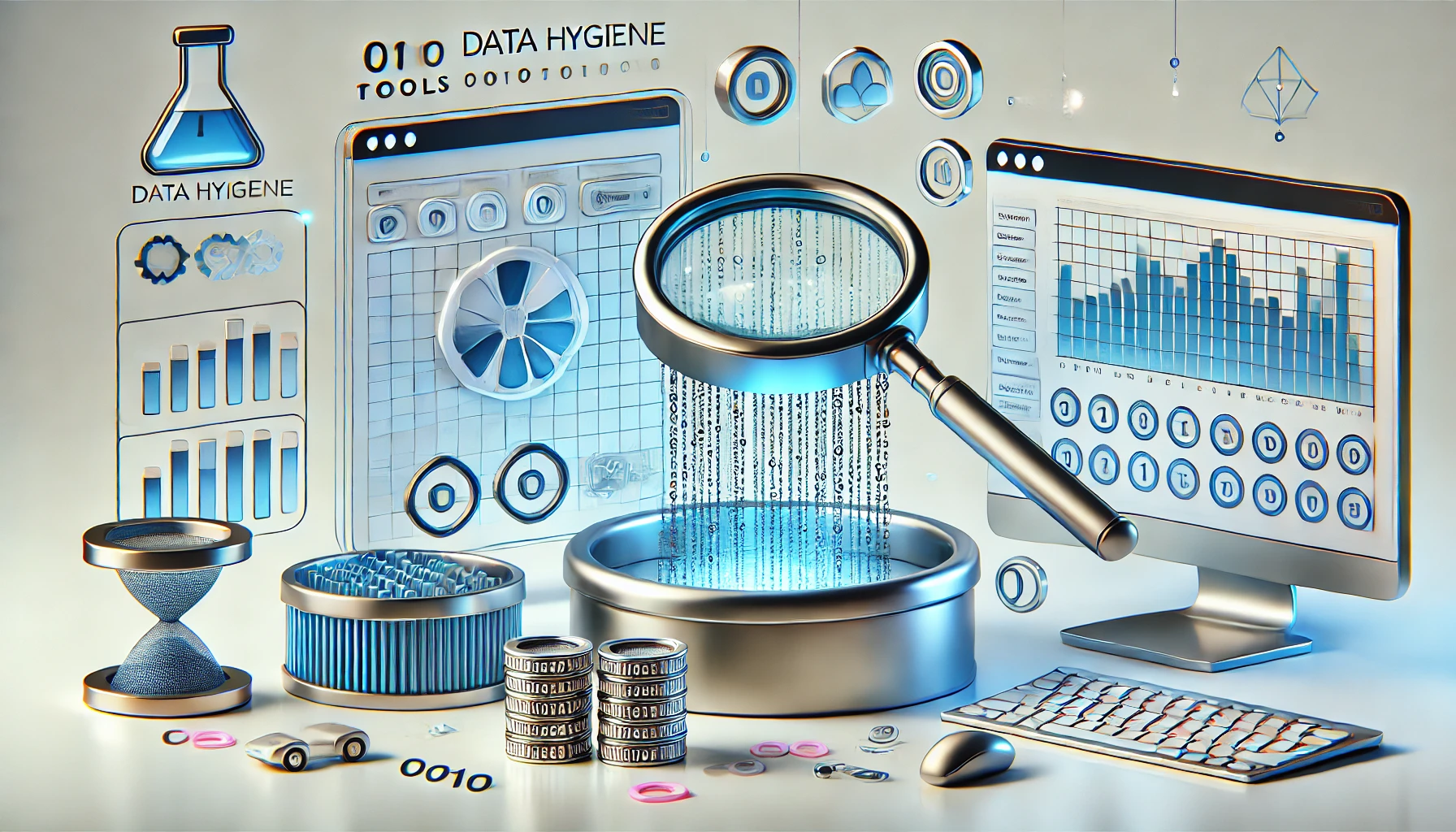You rely on clean data for informed decision-making. The right tools can make all the difference. Imagine having the power to ensure your data is accurate, up-to-date, and free from errors. These tools not only streamline processes but also enhance the overall quality of your data. So, which tools should be on your radar for effective data hygiene services? Let’s explore the top 10 must-have tools for data hygiene services that could transform the way you manage your data integrity.
Data Cleansing Tools
When it comes to maintaining the accuracy and reliability of your data, data cleansing tools are essential. Implementing data enrichment strategies and adhering to data hygiene best practices are crucial for ensuring the quality of your data. Data cleansing tools play a vital role in this process by identifying and correcting errors, inconsistencies, and duplicates within your datasets.
These tools streamline the cleaning process by automating tasks such as standardizing formats, removing outdated information, and validating data entries against predefined rules. By utilizing data cleansing tools, you can enhance the overall quality of your data, leading to more informed decision-making and improved business outcomes.
Incorporating data cleansing tools into your data hygiene services allows you to maintain a high level of data accuracy and integrity. By regularly cleansing your data, you can prevent inaccuracies from impacting your analyses and operations, ultimately saving time and resources in the long run. Make data cleansing tools a cornerstone of your data management strategy to ensure a solid foundation for your data-driven initiatives.
Data Validation Tools
To maintain the integrity and reliability of your data, the use of data validation tools is paramount. Data accuracy and completeness are crucial aspects of data quality that can be ensured through the effective implementation of these tools. Data validation tools help in verifying that the information entered meets the required standards and formats, reducing errors and inconsistencies within the dataset.
These tools perform various checks, such as validating email addresses, ensuring numeric fields contain only numbers, and confirming dates are entered in the correct format. By flagging inaccurate or incomplete data, these tools enable you to address issues promptly, enhancing the overall quality of your database.
Additionally, data validation tools can help in preventing duplicate entries, ensuring that each record is unique and eliminating redundancy. By incorporating these tools into your data hygiene services, you can enhance the accuracy and completeness of your data, thereby improving the effectiveness of your business operations.
Data Deduplication Tools
Data deduplication tools are essential for maintaining data cleanliness and accuracy within your database. By utilizing data matching techniques, these tools help identify and eliminate duplicate records, ensuring that your database is free from redundant information. Duplicate record identification is a critical aspect of data hygiene best practices, as it prevents errors and inconsistencies that can arise from having multiple instances of the same data.
Data deduplication tools streamline the process of identifying and merging duplicate records, saving you time and effort. These tools also support data hygiene automation, allowing you to set up rules and schedules for regular deduplication processes. By incorporating data deduplication tools into your data hygiene strategy, you can enhance the quality of your database and improve the overall efficiency of your data management practices.
Data Enrichment Tools
To optimize the quality and utility of your database, the next critical step after addressing duplicate records is to leverage data enrichment tools. Data enrichment strategies play a crucial role in enhancing the accuracy and completeness of your data. By utilizing these tools, you can fill in missing information, update outdated records, and enhance the overall value of your database.
Client engagement is a key aspect of data enrichment. By understanding your clients’ needs and preferences, you can tailor your data enrichment strategies to provide them with more personalized and relevant information. This personalized approach not only improves client satisfaction but also increases the likelihood of successful client interactions.
When considering data enrichment tools, it is essential to focus on customization. Customized solutions can help you achieve a higher Enrichment ROI by ensuring that the enriched data aligns with your specific business goals and objectives. By investing in tailored data enrichment tools, you can optimize the accuracy and effectiveness of your database while enhancing client engagement and satisfaction.
Data Integration Tools
Optimizing the seamless flow of data within your systems is a critical aspect of maintaining the integrity and efficiency of your database. Data integration tools play a pivotal role in achieving this goal by enabling smooth data mapping strategies and efficient data migration techniques.
For effective data integration, it is essential to utilize tools that support real-time data sync, ensuring that the most up-to-date information is available across all your systems. Real-time data sync capabilities help in preventing data inconsistencies and errors that may arise from delays in updating information.
Moreover, data integration tools facilitate data transformation processes, allowing you to convert data into the required format for seamless integration across different platforms or applications. These tools streamline the process of harmonizing data from various sources, ensuring data accuracy and consistency throughout your database.
Data Verification Tools
When it comes to data verification tools, ensuring accuracy in data is paramount. With a variety of validation software options available, you can choose the one that best suits your specific needs. Data quality assurance is a key component of any data hygiene service, and these tools play a crucial role in maintaining the integrity of your datasets.
Accuracy in Data
Ensuring the accuracy of your data is crucial for effective decision-making and operational efficiency. To maintain data accuracy, employ strategies such as regular data cleansing, validation processes, and implementing data quality tools. The impact of inaccurate data can be detrimental, leading to flawed analyses, poor business decisions, wasted resources, and damaged relationships with customers. By prioritizing data accuracy, you can enhance the overall quality of your operations.
Data accuracy strategies involve conducting regular audits to identify and rectify errors, ensuring data is up-to-date and relevant. Implementing strict data entry protocols and validation checks can prevent inaccuracies at the point of entry. Utilizing data deduplication tools can help eliminate redundant information, improving the integrity of your database.
Validation Software Options
To enhance the accuracy and reliability of your data, employing validation software options, also known as data verification tools, is essential. These tools help ensure that your data is clean, consistent, and error-free. When considering validation software options, look for solutions that offer cost efficiency and a user-friendly interface to streamline the verification process effectively.
Here are three key features to consider when evaluating validation software options:
- Automated Validation: Look for software that provides automated validation processes to save time and improve efficiency. Automated validation can help detect errors quickly and accurately, reducing the need for manual intervention.
- Real-Time Data Validation: Opt for tools that offer real-time data validation capabilities. Real-time validation allows you to identify and correct errors as data is entered, ensuring data accuracy from the start.
- Customizable Validation Rules: Choose software that allows you to customize validation rules to align with your specific data requirements. Customizable rules enable you to tailor the validation process to your unique needs, enhancing the accuracy and quality of your data.
Data Quality Assurance
For a robust data management strategy, focusing on Data Quality Assurance is paramount. Data enhancement strategies are essential for maximizing the value of your data. By utilizing tools that offer Data completeness analysis, you can ensure that your datasets are comprehensive and accurate. Data consistency metrics play a crucial role in identifying and rectifying discrepancies within your data. These metrics help in maintaining uniformity and reliability across all your databases. Implementing Data cleansing best practices is key to improving the overall quality of your data. By utilizing advanced tools that offer automated data cleansing capabilities, you can streamline the process of identifying and resolving errors, duplicates, and inconsistencies within your datasets. Embracing these Data Quality Assurance techniques will not only enhance the accuracy and reliability of your data but also optimize the performance of your data-driven processes.
Data Normalization Tools
When it comes to data normalization tools, key data fields play a crucial role in ensuring consistency across your datasets. Standardization techniques help in harmonizing diverse formats and structures into a unified system. Implementing data quality checks further enhances the accuracy and reliability of your normalized data.
Key Data Fields
One critical aspect of data normalization tools is the identification and standardization of key data fields. When it comes to managing data effectively, ensuring that key data fields are consistent and accurate is paramount to the success of any data hygiene service. Here are three key components to consider:
- Data Completeness Assessment: Conducting a thorough evaluation of all data fields to ensure that they contain all the necessary information required for analysis and decision-making is essential. This involves checking for missing values and incomplete data entries.
- Data Consistency Analysis: Analyzing data fields for consistency ensures that the information provided is uniform and follows a standard format. Inconsistencies in data can lead to errors in reporting and decision-making, making consistency analysis a crucial step in data normalization.
- Data Field Mapping: Mapping data fields involves linking disparate data sources to create a unified view. This process helps in understanding how different fields relate to each other and aids in standardizing data across various sources for better analysis and insights.
Standardization Techniques
Standardization techniques play a crucial role in data normalization tools, ensuring consistency and uniformity in the information processed. Data standardization benefits include improved data quality, enhanced decision-making processes, and increased operational efficiency. By standardizing data, organizations can eliminate duplicates, errors, and discrepancies, leading to a more reliable database. However, challenges in data standardization may arise from variations in data formats, languages, and sources, requiring robust tools to harmonize the information effectively.
The importance of data standardization in analytics cannot be overstated. Standardizing data allows for accurate comparisons between different datasets, enabling organizations to derive meaningful insights and make informed decisions. In analytics, standardized data ensures that the results are reliable and consistent, leading to more accurate predictions and actionable recommendations. As a critical step in the data hygiene process, standardization techniques pave the way for successful data analysis and interpretation, ultimately driving business growth and success.
Data Quality Checks
During data hygiene services, conducting thorough data quality checks is essential to ensure the accuracy and consistency of your dataset. When it comes to data quality, paying attention to both data accuracy and data completeness is crucial. Here are three key tools for data quality checks:
- Data Profiling Tools: These tools analyze the content and structure of your data to identify anomalies, duplicates, and missing values. By using data profiling tools, you can gain insights into the quality of your dataset and take corrective actions to enhance data accuracy.
- Data Cleansing Software: Data cleansing software helps in standardizing and correcting data inconsistencies, ensuring data accuracy. It can automatically detect and rectify errors such as misspellings, formatting issues, and incomplete records, thus improving the overall quality of your dataset.
- Data Quality Dashboards: Utilizing data quality dashboards can provide visual representations of data quality metrics, highlighting areas that require attention. These dashboards enable you to monitor data completeness and accuracy in real-time, allowing for timely interventions to maintain data integrity.
Data Monitoring Tools
To effectively maintain the accuracy and integrity of your data, utilizing robust data monitoring tools is essential. Data monitoring strategies involve the continuous observation of data to ensure its quality and security. Real-time monitoring is crucial for identifying issues as they occur, allowing for immediate action to be taken. By incorporating predictive analytics, data monitoring tools can help anticipate potential data issues before they escalate, enabling proactive measures to be implemented.
Anomaly detection plays a significant role in data monitoring by flagging unusual patterns or discrepancies in the data. These anomalies could indicate errors, inconsistencies, or even security breaches that need to be addressed promptly. Data monitoring tools equipped with anomaly detection capabilities provide a layer of protection against data corruption and unauthorized access.
Email Verification Tools
When it comes to Email Verification Tools, accuracy is paramount in ensuring clean and reliable data. Efficient verification processes can streamline workflows and save valuable time. Integration with existing data systems is crucial for seamless operations and maintaining data integrity.
Accuracy in Email Verification
Regularly checking the accuracy of email addresses is a crucial aspect of maintaining data integrity and ensuring successful communication with clients and customers. To achieve accurate email verification, consider the following:
- Email Hygiene Best Practices: Implement email hygiene best practices to keep your email list clean and up-to-date. Regularly remove inactive or invalid email addresses to prevent bounce-backs and maintain high deliverability rates.
- Email Validation Techniques: Utilize advanced email validation techniques to ensure the accuracy of email addresses. Tools that verify email syntax, domain validity, and mailbox existence can help in filtering out inaccurate or fraudulent email addresses.
- Real-Time Verification Services: Opt for real-time verification services that instantly validate email addresses upon entry. By integrating real-time verification into your data collection processes, you can prevent typos, reduce bounce rates, and enhance overall data quality.
Efficiency of Verification Process
Efficiency in the verification process is crucial for maintaining data integrity and ensuring accurate communication with your clients and customers. When it comes to email verification tools, incorporating automated processes is essential for streamlining the verification workflow. Automated processes can significantly reduce manual errors and speed up the verification process, ensuring that your data is clean and up-to-date. Real-time verification is another key feature to look for in email verification tools. Real-time verification allows for instant validation of email addresses as soon as they are entered, preventing inaccurate or outdated data from entering your system. By leveraging automated processes and real-time verification, you can enhance the efficiency of your verification process, leading to improved data quality and better communication with your clients and customers. Choose tools that offer these features to optimize your data hygiene services and ensure the accuracy of your email communications.
Integration With Data Systems
Integration with data systems is a critical aspect to consider when selecting email verification tools for your data hygiene services. Ensuring data system compatibility and seamless data migration integration are key factors in maximizing the effectiveness of your email verification process. Here are three crucial considerations to keep in mind:
- API Compatibility: Look for email verification tools that offer robust Application Programming Interface (API) support. This allows for easy integration with your existing data systems, enabling automated verification processes without manual intervention.
- CRM Integration: Choose email verification tools that can seamlessly integrate with Customer Relationship Management (CRM) systems. This integration streamlines data verification within your CRM platform, ensuring that your customer data remains accurate and up to date.
- Scalability: Opt for tools that offer scalability in terms of data processing and storage. Scalable solutions can handle large volumes of data efficiently, making them ideal for businesses of all sizes with varying data verification needs.
Data Profiling Tools
When it comes to maintaining the quality and accuracy of your data, one indispensable tool to consider is Data Profiling Tools. These tools offer a range of benefits, including identifying inconsistencies, duplicates, and missing data within your datasets. By analyzing the content and structure of your data, data profiling tools can help you gain valuable insights into the overall health of your data and ensure its reliability for making informed business decisions. However, utilizing data profiling tools also comes with its own set of challenges, such as dealing with large volumes of data and interpreting complex results accurately.
To make the most of data profiling tools, it is essential to follow best practices and techniques. This includes setting clear objectives for data profiling, understanding the specific requirements of your data, and regularly updating your profiling processes to adapt to changing data formats. By incorporating these best practices, you can leverage data profiling tools effectively to enhance the overall quality and integrity of your data.
Frequently Asked Questions
How Do Data Hygiene Services Protect Against Cybersecurity Threats?
To safeguard against cybersecurity threats, data hygiene services employ advanced data encryption techniques, ensuring compliance with cybersecurity regulations. By meticulously cleansing and organizing data, your sensitive information is shielded from potential breaches with ironclad protection.
Can Data Hygiene Tools Handle Unstructured Data Formats?
Yes, data hygiene tools can handle unstructured data formats. They address unstructured data challenges by enhancing compatibility with various formats. This capability ensures comprehensive data cleansing and protection, safeguarding against cybersecurity threats that may exploit vulnerable data structures.
Are There Tools Available for Real-Time Data Monitoring?
Yes, there are real-time monitoring tools that can help ensure data privacy compliance. These tools allow you to track data flows, detect anomalies, and respond promptly to any breaches, enhancing your overall data hygiene practices.
How Can Data Enrichment Tools Improve Customer Segmentation?
Utilize data enrichment tools to enhance data quality, allowing for more precise customer segmentation. By leveraging these tools, you can extract valuable insights, enabling targeted marketing strategies that resonate with specific customer needs and preferences.
Do Data Validation Tools Support International Address Formats?
Yes, data validation tools are essential for ensuring data standardization and accurate address verification across international formats. These tools help maintain data integrity by validating and correcting addresses to adhere to specific country requirements for optimal accuracy.




